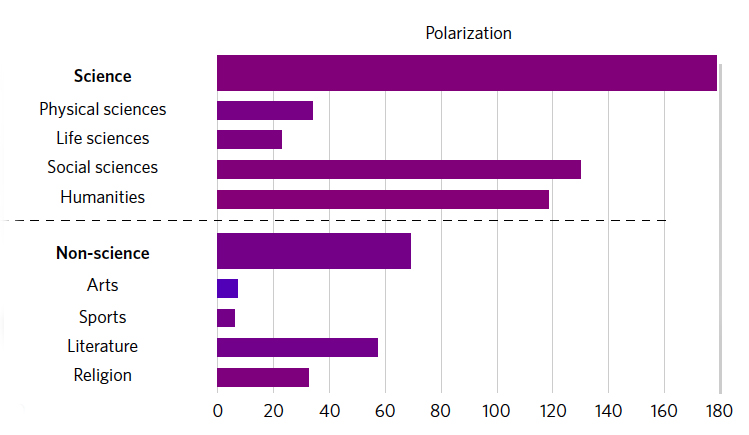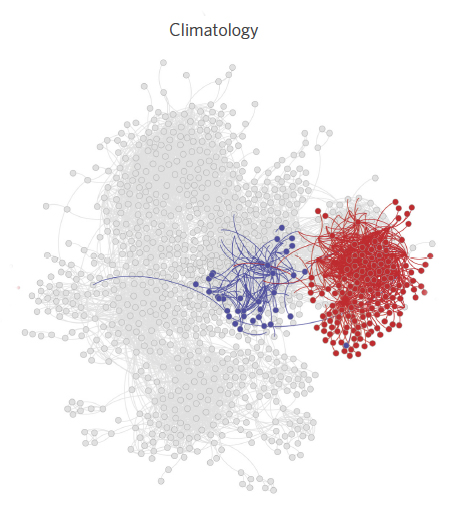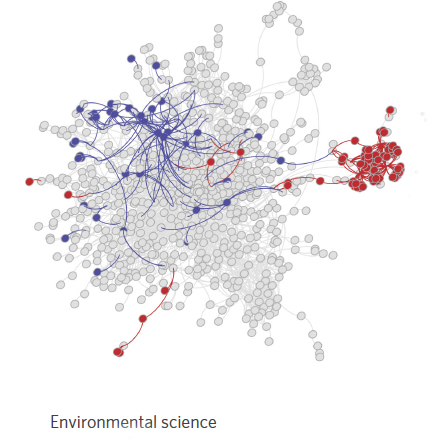
Is science political? If you consider climate change, you will find vast divisions of thought, frequently along ‘party lines’, much like you will with drug discovery. On the other hand, there is little political wrangling about oxidative phosphorylation or T-cells.
A new paper in Nature Human Behavior explores the political dimensions of science utilizing a fascinating technique. Anyone who has used Amazon.com or Barnes and Noble to order books knows that they make recommendations based upon your purchases. These recommendations are based on sales. The researchers made use of that feature in looking at what science books were acquired by the two traditionally cited political distinctions, liberal and conservative.
How did they know a consumer's political affiliation? They used a purchase of two canonical political books as their 'seed' to start building their networks. Barack Obama’s "Dreams from My Father" was the seed for liberal viewpoints and Mitt Romney’s "No Apology" the seed for conservatives.
The researchers mined the 100 recommended books and chose the political books that were associated with these two books. After repeating this enough times, they compiled two stable lists of political books that were recommended from those books - a network of the top conservative and liberal political books.
Using this network of books, they then re-queried the 100 recommended books, that were based on co-purchasing, now searching for every science and non-science (and non-political) book in the recommendations. Once again, they repeated the process until they had a listing of common science book choices falling along liberal and conservative lines, based on the people who had bought political books. They had defined networks of the most popular (by sales) science books bought by individuals who fell into those distinct political camps. They used these market created networks to analyze how the conservative (red) readers and the liberal (blue) readers read, and perhaps, thought about science.
They found that, with respect to political books, red and blue book readers had the same behavior. In both groups, over 93% of people read the political books that were linked to their own network - red book readers read other red books and blue book readers read blue books. [No surprise here for those that follow the polarization of politics]
Science books attract similar overall interest from liberals and conservatives because both groups are buying them at the same rate. But, when the science books were analyzed for "polarization," (1) the choices were more polarized than non-science books. this can be seen in the graph below. This was more apparent in the social sciences and humanities, while the physical and life sciences are similar to non-science overall.  [Again, not a particular surprise if you refine the distinction as between the ‘hard’ and ‘soft’ sciences]
[Again, not a particular surprise if you refine the distinction as between the ‘hard’ and ‘soft’ sciences]
In order to investigate further, books within a particular scientific discipline were visualized as a network. Books in the center of the network were those books that were most ‘purchased’ within that discipline. You might consider the central books to be the current dogma or general beliefs within a discipline.
Climatology (as shown to the left) provides an excellent example of the  visualization. In this diagram, all of the books on climatology are represented. But, there is a distinct polarization in the choice of books [note the separation of blues from reds]. Red books [those pesky conservatives] were often near the periphery – meaning that the books chosen were less likely to be ‘relevant,' further away from the central common beliefs.
visualization. In this diagram, all of the books on climatology are represented. But, there is a distinct polarization in the choice of books [note the separation of blues from reds]. Red books [those pesky conservatives] were often near the periphery – meaning that the books chosen were less likely to be ‘relevant,' further away from the central common beliefs.
Another distinction between the two groups can be seen in the network visualizing environmental science. Blue readers had a broader selection of books within the discipline; red readers were more focused in certain areas. These differences are more accentuated in the more polarized subject matter. [Notice how much larger an area the blue books cover in the environmental science visualization.]
In conclusion, people who buy liberal and conservative political books are more likely to buy books on science than non-science.
And simply put, "even when left and right are equally likely to read books in a discipline, they are rarely the same books or even from the same topical cluster."
And one more thought for the sake of due diligence.
Applied disciplines such as medicine and law attract readers at the red end compared with other disciplines in their respective schools, whereas anthropology and astronomy attract readers at the blue end. This mirrors the ideological differences among scientists employed in academia versus industry, as reported in AAAS/Pew surveys from 2009 and 2014. A possible interpretation is that scientific puzzles appeal more to the left, while problem-solving appeals more to the right.
Whether I see a real distinction between problem-solving and puzzles is a topic for another article.
Footnotes:
(1) Each political book was examined by two independent coders and was classified as liberal, conservative or indeterminant based on two criteria 1) the book must express an ideological position on a partisan political or social issue and 2) the espoused ideology must be consistently liberal or conservative. A total of 667 conservative, 587 liberal and 2,545 indeterminant books were identified. The coders concurred 83.5% of the time, and the remaining instances were identified by a third ‘tie-breaking’ coder or the book’s author. In an attempt to control for bias, an additional 315 indeterminant books written by members of Congress were included in the test set basing their categorization as red or blue on the author's known political affiliation. The inclusion of these indeterminant books had no impact on the reported results.
To determine the polarization of books a mathematical formula was used to calculate the overlap in purchases of a book by both red and blue readers. As the degree of overlap decreased (number of purchases by red and blue readers) the extent of polarization increased.
